Slovenia 2020 "Mammal Fossils In Slovenia: Prohyracodon telleri"
| <prev | back to index | next> |
| Issue Date | 13.03.2020 |
| ID | Michel: Scott: Stanley Gibbons: Yvert: Category: pF |
| Design | Zlatko Drčar |
| Stamps in set | 1 |
| Value | €0.95 - Prohyracodon telleri |
| Emission/Type | commemorative |
| Place of issue | Kamnik |
| Size (width x height) | 42.60 mm x 29.82 mm |
| Layout | Sheet of 25 stamps |
| Products | FDC x1 |
| Paper | Tullis Russell Chancellor Litho PVA RMS GUM, 102 g/m2 |
| Perforation | 14 x 14 |
| Print Technique | Offset, 4 colours |
| Printed by | Agencija za komercijalnu djelatnost d.o.o., Zagreb, Croatia |
| Quantity | 40.000 |
| Issuing Authority | Posta Slovenije |
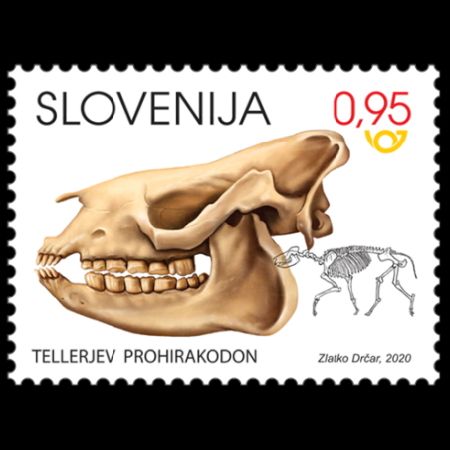
On March 13th, 2020 Slovenian Post Authority issued the fifth stamp of their multi-year set of "Mammals fossils in Slovenia" showing fossil and reconstruction, on the FDC, of Prohyracodon telleri.
The first stamp of the set was issued in 2016 and shows a fossil of a cave bear.
Prohyracodon telleri is the oldest prehistoric mammal fossil from Motnik village in the Municipality of Kamnik and also known as a Dwarf Rhinoceros.
The following paragraph was written by Matija Kriznar MSc, palaeontologist and senior curator Slovenian MNatural History Museum and was published in a bulletin Nr. 130 of Slovenian Post in 2020.
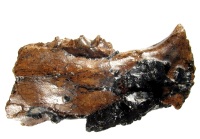 |
| The image credit: Kamnik Museum |
Motnik and its surrounding area were once the site of coal exploration and mining.
Miners in years past unearthed a variety of fossil remains in the underground tunnels of the area's coal mines.
In the second half of the nineteenth century these included the osseous remains of vertebrates,
which had evidently been quite common.
In 1910 the Viennese palaeontologist Othenio Abel classified the remains of a fossil mammal as belonging to
the new genus and species Meninatherium telleri.
Later forgotten, Meninatherium was rescued from oblivion by the palaeontologist Kurt Heissing,
who on examining remains in Austrian palaeontological collections was of the opinion that they
belonged to the Prohyracodon genus.
As a result, the Motnik fossils gained the new scientific name Prohyracodon telleri,
or "Teller's prohyracodon".
Teller's prohyracodon was a medium large mammal the size of a mouflon.
It lived in the marshy flatlands where coal formed in freshwater basins.
The marshes were also inhabited by crocodiles and other mammals such as Anthracohyus slovenicus.
These remains show that the coal-bearing strata in the Motnik area probably formed approximately 40
million years ago, in the geological period of the late Eocene.
This means that Teller's prohyracodon, like the other Motnik remains, is among the oldest fossil mammals found in Slovenia.
Due to the fact that Prohyracodons is known from few fragmentary fossils only, it was impossible to make a precise reconstruction of the animal. Perhaps this is the reason for the stamp designer to use reconstruction of similar animal: Hyracodon nebraskensis, from the German book "Phylogenie der Mammalia, Stammesgeschichte der Saeugetiere von Eric Thenius" published in Berlin 1969, for the stamp and First-Day-of-Issue Postmark.
 |
||
| The drawings of the skull and skeleton of Hyracodon nebraskensis, by Eric Thenius. (Compare it with the stamp and the postmark) | The skeleton of Hyracodon in the Natural History Museum of Los Angeles, USA | Reconstruction of the Eocene hyracodont rhino Hyracodon, by Carl Buell in the American Natural History Museum in New York, USA |
| Image credits: book "Phylogenie der Mammalia, Stammesgeschichte der Saeugetiere von Eric Thenius" | Image credit: Wikipedia | Image credit: AMNH website |
The entire skeleton of Hyracodon nebraskensis can be seen in Natural History Museum of Los Angeles for example.
Hyracodon was a lightly built, pony-like mammal of about 1.5 meters long. Its skull was large in comparison to the rest of the body. Hyracodon's dentition resembled that of later rhinoceroses, but it was a much smaller animal and differed very little in appearance from the primitive horses of which it was a contemporary (32–26 million years ago).
Hyracodon was perhaps the most unusual of the rhinos in that they had long slender limbs and feet. In this sense they were more horse-like in body proportions than other rhinos although, unlike horses, hyracodonts retained three toes on all four feet.
Products and associated philatelic items
| FDC | First-Day-of-Issue Postmark | Stamp Sheet |
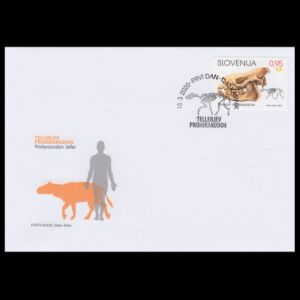 |
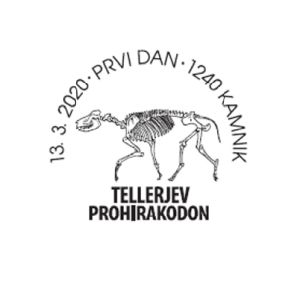 |
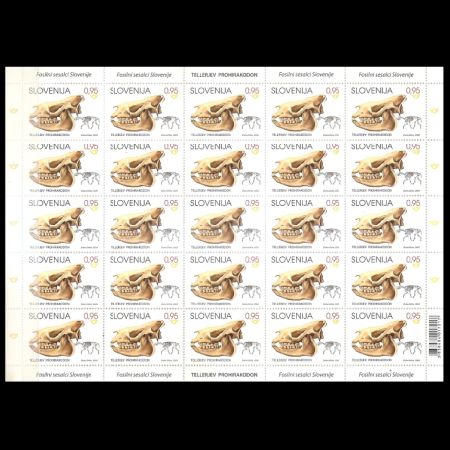 |
| Example of circulated cover | ||
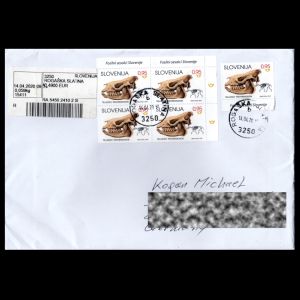 |

|
References
- Technical details and short description: Posta Slovenije, Bulletin Nr. 130 (page 8 with text in Slovenian, German and English languages), colnect.
- Dwarf Rhinoceros, Jaw, Motnik:
Kamnik Museum - Hyracodon:
Wikipedia, American Museum of Natural History.
"Phylogenie der Mammalia, Stammesgeschichte der Saeugetiere von Eric Thenius" (p. 544), published by Walter de Gruyter an Co. in Berlin in 1969.
Acknowledge
- Many thanks to Mr. Rudolf Hofer, editor of Paleontology column in Glueckauf magazine of Arbeitsgemeinschaft Bergbau und Geowissenschaften e. V., who drew my attention to the difference between the animal’s name and its reconstruction on the stamp.
- Many thanks to Mr. Matija Kriinar, paleontologist and senior curator Slovenian Natural History Museum, for clarifications and nice conversation on facebook.
- Many thanks to Dr. Peter Voice from Department of Geological and Environmental Sciences, Western Michigan University, for reviewing the draft page.
| <prev | back to index | next> |